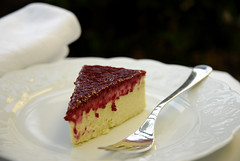 Brigadeiro is a Brazilian chocolate fudge candy shaped like a truffle and named after Brigadeiro Eduardo Gomes. He was an air force brigadier who also ran unsuccessfully for the presidency in 1946 and 1950. It has been said that he was very handsome and single, therefore he conquest a large number of female fans that helped him organizing his promotional parties. One day, for one of the parties, they created a new pastry and named it after him. Besides this cute story, it is believed that the success of the candy was a combination of opportunities: the shortage of traditional imports because of the war and the need to find replacements, the introduction of the chocolate powder by Nestlé in the country, its ease of manufacture and the fact that people already appreciated condensed milk and everything made of it (Nestlé initiated their production in Brazil in 1921 and the condensed milk was the first product they made, it was and still is their biggest seller).
Brigadeiro is a Brazilian chocolate fudge candy shaped like a truffle and named after Brigadeiro Eduardo Gomes. He was an air force brigadier who also ran unsuccessfully for the presidency in 1946 and 1950. It has been said that he was very handsome and single, therefore he conquest a large number of female fans that helped him organizing his promotional parties. One day, for one of the parties, they created a new pastry and named it after him. Besides this cute story, it is believed that the success of the candy was a combination of opportunities: the shortage of traditional imports because of the war and the need to find replacements, the introduction of the chocolate powder by Nestlé in the country, its ease of manufacture and the fact that people already appreciated condensed milk and everything made of it (Nestlé initiated their production in Brazil in 1921 and the condensed milk was the first product they made, it was and still is their biggest seller). Brigadeiro is a very sweet candy, as others typical pastries from Brazil and that’s the way a lot of people like them. We here have a strong influence from Portugal, which also has a very sweet pastry tradition, heritage from the Arab culture.
Brigadeiro has to be present in every kid’s birthday party all over Brazil, despite their economic class or background. That’s one thing for sure all Brazilians have in common. Because its very easy to do its one of the first things we learn how to cook. It also can be done almost anywhere, even when you’re camping, as I did once.
Nowadays we have fancy gourmet brigadeiros in Brazil, they are made with high quality cocoa and different flavor combinations. They are sold in really cute stores and come in nice packaging. Check out the first gourmet brigadeiro store in Sao Paulo: http://www.mariabrigadeiro.com.br/index.htm
Here's the basic recipe, but you can try mixing different ingredients and create your own gourmet brigadeiro!
Recipe:
1 can of condensed milk
1 tablespoon of butter
3 tablespoons of chocolate powder
Put all the ingredients in a pan over low heat, stirring constantly to obtain a smooth, sticky texture, about 10 minutes. To know if it’s ready you tilt the pan and the mixture has to run from the bottom. There are two ways to serve brigadeiro. The traditional method is to roll the candy into balls which are then covered in chocolate. The second method is to leave the candy slightly more fluid and to eat it with a spoon. Brigadeiro can also be used as a topping or covering for cakes, ice cream and crepes.






